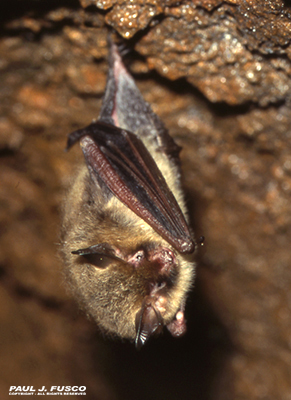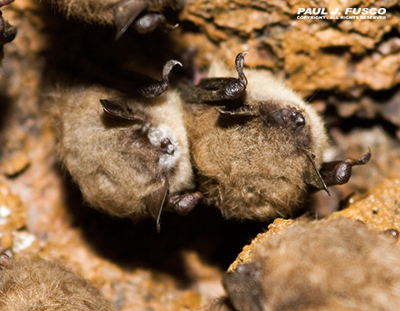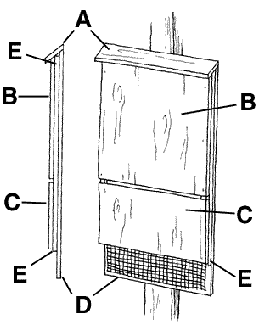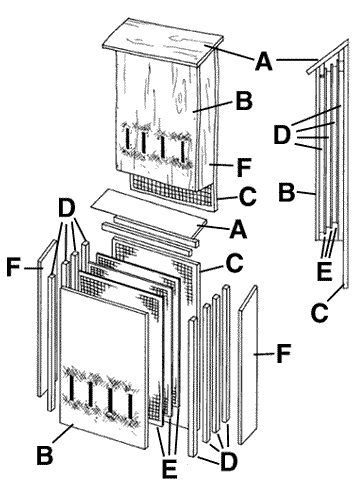Bats
Help the Wildlife Division Monitor Bats
Bats Count! Live Bat Cam at White Memorial Conservation Center in Litchfield
Discover and appreciate bats on our Bats and Old New-Gate Prison and Copper Mine webpage.
Background
 Bats are among the world’s most fascinating, beneficial and likable animals, yet people often fear and misunderstand them. They are the only mammals capable of true flight. There are over 1,300 different species of bats in the world – nine different species of bats can be found in Connecticut, and all but one of them (the big brown bat) are on Connecticut's List of Endangered, Threatened and Special Concern Species.
Bats are among the world’s most fascinating, beneficial and likable animals, yet people often fear and misunderstand them. They are the only mammals capable of true flight. There are over 1,300 different species of bats in the world – nine different species of bats can be found in Connecticut, and all but one of them (the big brown bat) are on Connecticut's List of Endangered, Threatened and Special Concern Species.
The little brown and big brown bats were the most common bat species found in Connecticut until white-nose syndrome (WNS) was documented in the state in 2008. Several Connecticut bat populations have been devastated by WNS. The affected species, known as “cave bats”, have declined so dramatically that several were added to Connecticut’s List of Endangered, Threatened and Special Concern Species in 2015. The big brown bat is considered a Species of Greatest Conservation Need (GCN) in Connecticut's Wildlife Action Plan, along with all of the state-listed bat species.
The three species of tree-roosting bats – silver-haired, hoary, and red bat – are not adversely affected by WNS, but their populations have declined from historical levels in eastern woodlands. They occur in relatively low numbers throughout Connecticut. All three have been listed as species of special concern in Connecticut since the first official list was released in 1992.
Connecticut Bats and their Status
| Common Name | Scientific Name | CT Status (2015)* | Federal Status* |
|---|---|---|---|
| Big brown bat |
Eptesicus fuscus |
GCN | |
| Little brown bat |
Myotis lucifugus |
E, GCN | |
| Northern long-eared bat |
Myotis septentrionalis |
E, GCN | T |
| Eastern small-footed bat |
Myotis leibii |
E, GCN | |
| Indiana bat |
Myotis sodalis |
E, GCN | E |
| Tri-colored bat |
Perimyotis subflavus |
E, GCN | |
| Silver-haired bat |
Lasionycteris noctivagans |
SC, GCN | |
| Eastern red bat |
Lasiurus borealis |
SC, GCN | |
| Hoary bat |
Lasiurus cinereus |
SC, GCN |
* GCN= Greatest Conservation Need
E= Endangered
SC= Special Concern
T=Threatened
White-nose Syndrome
White-nose syndrome (WNS) is an epidemic in cave-roosting bat species that is causing tragic and extensive mortality in hibernating bats in eastern and midwestern North America. The U.S. Fish and Wildlife Service estimated in 2012 that 5.7 million to 6.7 million bats had perished in the eastern United States and Canada since WNS was discovered in New York in 2006. For certain species, mortality has reached 90 to 100 percent. In Connecticut, dramatic losses have been documented for the northern long-eared bat, little brown bat, and tri-colored bat. While the big brown bat and eastern small-footed bat have also experienced significant declines due to WNS, losses are not as severe as those experienced by other species.
Researchers have determined that WNS is caused by a fungus, Pseudogymnoascus destructans (Pd), which is visible as a white powdery growth on the muzzle and skin of hibernating bats. This fungus thrives in the cold and humid conditions characteristic of caves and mines bats use for hibernation. WNS is transmitted primarily from bat to bat, particularly where bats gather in clusters to over-winter in their underground hibernation sites. In addition, people may inadvertently carry fungal spores from cave to cave on their clothing and gear when visiting the caves.
The Pd fungus infects the muzzle and wings of bats during hibernation when metabolism and immune systems in bats are largely shut down. Research indicates that bats infected with the Pd fungus awaken more frequently from hibernation and burn their precious fat reserves. Bats with depleted energy reserves do not make it through winter, and are sometimes observed desperately searching for food and water in the winter months, only to perish due to exposure and lack of food.
Since 2007, the DEEP Wildlife Division has been an active participant in the WNS response. Biologists continue to monitor hibernating bats for signs of WNS to document mortality. They also are tracking summer maternity colonies closely to see whether WNS is having a negative effect on bat survival and reproduction.
Guided by the White-nose Syndrome National Plan, published in 2010, biologists and researchers across North America are working to curb the spread of WNS and develop ways to safely treat or control the Pd fungus. Many of these efforts have been supported by the State Wildlife Grants program, an important source of funding for addressing urgent wildlife disease issues.
More information on white-nose syndrome and related conservation efforts can be found at www.whitenosesyndrome.org.

Little brown bats with white-nose syndrome hibernating in a Connecticut mine.
What You Can Do
DEEP encourages residents to help monitor Connecticut’s bat populations. Bats found outdoors from mid-November through mid-March should be reported to the Wildlife Division. While the characteristic white fuzzy fungal growth may not be readily visible on a bat’s nose, bats seen flying during the day or clinging to the outside of a building during winter are a sign that white-nose syndrome may be at work. Sighting details, including the date, location, what you observed, and digital photos if possible, may be submitted by email to the DEEP Wildlife Division at deep.batprogram@ct.gov or by calling 860-424-3011.
Natural History of Bats
Bats are furred, warm-blooded mammals with body lengths of 3 to 6 inches on average and wingspans ranging from 8 to 16 inches. The bones in a bat’s wing are similar to those in human arms and hands. The fingers are extended and connected by leathery, elastic skin that grows from the sides of a bat’s body. The thumbs are free from the wing membrane and have claws for grasping.
Bats have good eyesight and rely on vision for long-distance orientation. For short-distance navigation and catching food at night, they use echolocation. This sonar system helps bats, like dolphins, locate targets and background objects from the echoes of ultrasonic pulses. The tempo of these pulses are slow when a bat is foraging and quicken as the bat pursues and captures an insect. Detection, pursuit, and capture of an insect take about one second.
Connecticut’s bats are primarily insect eaters. An exception is the hoary bat, which also eats other bats, namely the tri-colored bat. Bats are mostly nocturnal and almost always feed “on the wing.” They use their wings, the skin around their tails, and their mouths to catch insects in flight. Bats are the only major predators of night-flying insects, making them beneficial in several ways. They consume many agricultural pests, such as cutworm and corn borer moths, potato beetles, and grasshoppers. Mosquitoes and similar human pests are eliminated much more efficiently by bats than by birds or expensive bug zappers.
Interesting Facts
- In general, bats are not dangerous. Like any other mammal, they can carry rabies, although less than one percent of all bats are infected with the virus. More people die annually from dog attacks, bee stings, lightning, and household accidents than from bat-transmitted rabies.
- Bats are not flying mice. They are the only mammal capable of true flight and are more closely related to primates (and people) than to rodents.
- Bats do not get caught in people’s hair. They are adept fliers and rely on sensitive sonar (echolocation) to navigate night skies. Bats that swoop near people are after insects like mosquitoes and moths.
- Bats are not blind. They have good eyesight, but rely on echolocation to master night flight.
- Bats are not filthy or covered with parasites. Clean wings are essential for executing intricate flight patterns, so bats spend great amounts of time grooming themselves.
- Worldwide there over 1,300 kinds of bats; Connecticut has only nine native species.
- Only 3 species of bats feed on animal blood. These vampire bats prefer to drink cattle or bird blood and are only found in Latin America.
- The smallest bat is the size of a small mouse; the largest, a fruit eater, has a 6-foot wingspan.
- A single little brown bat can eat 1,200 mosquitoes and night-flying insects in an hour.
- Bats have varied diets: 70 percent eat insects; many tropical species eat fruit or drink flower nectar; and some bats even catch frogs and fish.
Build a Bat House
One of the best ways to help bats is to provide an artificial roost site by installing a specially-made bat house on your property. Pre-made bat houses can be purchased or you can build your own. The following factors are critical to the success of bat houses: maintaining suitable temperature ranges, the distance to food and water, the size and shape of inner roosting spaces, and roughness of clinging surfaces.
Bat house designs range from simple and small-scale to large and complex. Two of the simpler designs are shown here. The small bat house provides only one size roosting space and accommodates fewer bats. The large bat house provides many roosting options and is ideal for larger nursery colonies of females and young. Following are tips for constructing and installing a bat house:
- Use the roughest sides of the wood on the inner areas of the house. It also is a good idea to horizontally groove inner surfaces for footholds or attach non-metal screening to provide toe holds. This is also important for landing areas below the entrance.
- Caulk all outside seams to limit air flow. This helps trap the bats’ body heat inside the house. Sealants approved for aquarium or kitchen use are best.
- Place tar paper or dark shingles on the top of the box and 4 to 6 inches down the sides to increase inside temperatures. Nursery roosts often require temperatures of 90 degrees F or more. A dark stain also helps increase the temperature.
- Hang houses 10 to 15 feet above ground. South and southeast exposures are best for providing maximum thermal gain. Bats prefer houses that get at least 6 hours of sunlight a day.
- If possible, protect the house from prevailing winds and provide an unobstructed approach.
Bat houses attached to the sides of buildings have had the greatest reported success. Free-standing poles in open areas also work, but tree-mounted houses generally remain unused. Bat houses placed near water or wetland areas often are most successful. Installing a bat house before April improves the chance of occupancy. Do not be discouraged if bats do not immediately move into their new home. It is not unusual for a house to stand empty for at least a year before it is used.
To assist in conservation efforts, please report any bat house successes or failures to the DEEP Wildlife Division at deep.batprogram@ct.gov or 860-424-3011.
Small Bat House
 Use rough-cut lumber or exterior grade plywood (1/2-inch thick minimum). The furring strips (E) should have a finished thickness of approximately 3/4 inch.
Use rough-cut lumber or exterior grade plywood (1/2-inch thick minimum). The furring strips (E) should have a finished thickness of approximately 3/4 inch.
Staple 1/8-inch mesh (HDPE plastic) netting to back and front 2 sections. Make sure mesh extends to bottom of back.
Caulk all pieces and assemble with drywall screws to prevent wood from splitting. Apply additional caulk to outside joints as needed.
Apply dark stain to exterior surfaces and use tar paper or shingles on the roof and the top half of the bat house to increase interior temperatures.
A -- Roof, 4 inches by 14 inches
B -- Upper front, 12 inches by 20 inches
C -- Lower front, 12 inches by 10 inches
D -- Back, 12 inches by 36 inches
E -- Spacers, (1) 2 inches by 12 inches, (2) 2 inches by 30 1/2 inches
Large Bat House
 Use 1/2-inch exterior grade plywood for front and back sections; 1/4 inch for all partitions. Sides are 1 inch by 6 inch stock.
Use 1/2-inch exterior grade plywood for front and back sections; 1/4 inch for all partitions. Sides are 1 inch by 6 inch stock.
Staple 1/8-inch mesh (HDPE plastic) netting to all partitions and the back panel. Apply caulk to all joints.
Begin assembly by screwing the back to the sides. Attach 31-inch spacers to inside corners.
Place a partition on top of the spacers to within about 1/2 inch of the roof. Put the next set of spacers (26 inches) on top of the partition and screw into the first spacers.
Repeat for remaining partitions ending with 28 3/4 inch spacers (flush to roof line). Screw front to sides. Make sure roof angles are aligned.
Screw roof in place and caulk all exterior joints.
Scratch or roughen the front near the vents to provide a toe hold for bats landing on the box.
A dark stain should be applied to all exterior surfaces and tar paper or shingles to the roof and upper half of the house to increase interior temperatures.
A -- Roof, 6 inches by 28 inches
B -- Front, 24 inches by 28 3/4 inches (cut slots for vents, 5 inches above bottom edge)
C -- Back, 24 inches by 36 inches
D -- Spacers, 1 inch by 2 inches, (4) 26 inches long, (2) 31 inches long, (2) 28 3/4 inches long
E -- Partitions, 1/4 inch thick, 3/4 inches apart, 26 inches long
F -- Sides, 4 inches by 28 3/4 inches by 31 inches (angle-cut top edges)
Living with Bats
The presence of bats in buildings can be detected in several ways. At dusk, when bats leave roosts to feed, they may be seen exiting through eaves, vents, or from behind shutters or siding. Noise from large colonies may also announce their presence. Droppings and dark brown stains may appear near eaves and beneath entrance holes and roosts. Bat droppings (guano) are easily crushed, revealing shiny bits of undigested insects. Droppings are never white or chalky in appearance, like the droppings of birds.
The 2 most common bats involved in nuisance complaints are the little brown bat and big brown bat. The little brown bat ranges from 3.1 to 3.7 inches in length and has a wingspan of 8.6 to 10.5 inches. Big brown bats range from 4.1 to 4.8 inches in length, with a wingspan of 12.1 to 12.9 inches. Big brown bats can readily be distinguished from little brown bats in flight by their larger size, slow wingbeats, and audible chatter.
Removing a single bat: A bat that enters a home can often be removed easily. Closing off doorways to the room containing the bat and opening a window will usually prompt the bat to fly outside. A large jar or cardboard box may also be used to remove a bat. Move toward the bat slowly so that it is not startled and gently place the can over it. Slide stiff paper or cardboard under the opening, using it as a lid when removing the bat. Wear heavy leather gloves when removing a bat by hand. Bats, like all wild animals, may bite when handled and should not be removed bare-handed. Remember that bats, like other mammals, may be a source of rabies. The rabies virus is found in saliva and may be transmitted through the bite of an infected animal. If you are accidentally bitten while handling a bat, make sure the bat is saved for examination. Immediately wash the bite with soap and water and seek prompt medical advice. Non-bite exposures can also occur and should be treated in the same manner as a bite. A non-bite exposure occurs when saliva or brain tissue from an infected animal enters scratches, abrasions, open wounds, or mucous membranes (nose, mouth, eyes).
Dealing with a Bat Colony: Most colonies of bats are small and often remain unnoticed for many years. Large colonies residing in an attic or wall may become a nuisance because of noise and unsightly guano accumulations. Eviction and exclusion of roosting bats are the only safe, permanent solutions to a nuisance problem.
Exclusion and Bat-proofing: One of the simplest techniques for solving nuisance problems is letting the bats exit on their own and then preventing their re-entry to the roost. Little brown bats do not spend the winter in buildings, so bat-proofing can be done after they travel to their winter roost site. Big brown bats usually travel to other roosts also, but they have been known to use building roosts in winter. If nuisance problems involve big brown bats or if rapid exclusion is necessary, the first step is to find the exit(s) by watching the bats emerge at dusk. Stains from body oils or droppings may help pinpoint exits. Exclusion should not be done from June through mid-August, as flightless young may be trapped and die in the roost, causing severe odor problems.
A simple one-way exclusion gate can be made using half-inch polypropylene structural-grade bird netting. During the day, hang the netting around the exits, using staples or duct tape. The netting should be attached several inches above the exits and extend at least 2 feet to either side and below the exit. The sides may be attached, but the bottom must hang free. As bats leave to feed, they will drop out of the roost unhindered. When they return, they will be unable to fly directly into the roost. These exclusion nets should be left in place for 3 or 4 nights to insure that no bats remain in the roost. After exclusion, the openings can be repaired when convenient. Caulk, fine screen, and oakum (petroleum-soaked rope) are all easy items to use for sealing openings.
Another simple one-way excluder can be made from plastic strips. In a section of flexible plastic, cut small strips (about 1-inch wide) that will serve as tiny door flaps. The bats can push past them to exit, but the strips will not flex inward to allow re-entry. This excluder should be installed in the same manner as the bird netting.
Exclusion of bats from Spanish or concrete tile roofs is often as simple as installing a rain gutter. The gutters should be installed flush against the attachment surface. The upper edge of the gutter should be even with the lower edge of the tile, extending outward about 8 inches. This exclusion can be done any time because the bats are still able to leave. Bats dislike climbing over the slippery metal gutter and usually will not return.
If you prefer to hire someone to exclude and bat-proof your home, it is best to seek a specialist (Information on hiring a Nuisance Wildlife Control Operator). If the bats need to be trapped or handled, the specialist must be licensed by the DEEP Wildlife Division. As with any business dealing, it is advisable to get more than one estimate for the job. Beware of scare tactics, and remember:
- Bats do not multiply like rabbits.
- Even sick bats rarely attack people or pets.
- Bats are not attracted in hordes by the scent of other bats.
- Bats have very few parasites, so additional spraying for parasites is not necessary.
- Permanent physical exclusion is essential for any bat control job.
- The use of poisons to eliminate a bat colony is illegal without a special permit.
- Bat guano is not "toxic."
- Rabies rates in bat populations are not increasing.
For more information on bats, contact: DEEP's Wildlife Diversity Program at deep.batprogram@ct.gov or 860-424-3011 and also Bat Conservation International.
For more information on rabies, contact your local health department.
 The Technical Assistance Informational Series is 75 percent funded by Federal Aid to Wildlife Restoration - Pittman-Robertson (P-R) Program. The P-R Program provides funding through an excise tax on the sale of sporting firearms, ammunition, and archery equipment. The remaining 25 percent of the funding is matched by the Connecticut Wildlife Division. (rev. 8/2020)
The Technical Assistance Informational Series is 75 percent funded by Federal Aid to Wildlife Restoration - Pittman-Robertson (P-R) Program. The P-R Program provides funding through an excise tax on the sale of sporting firearms, ammunition, and archery equipment. The remaining 25 percent of the funding is matched by the Connecticut Wildlife Division. (rev. 8/2020)

